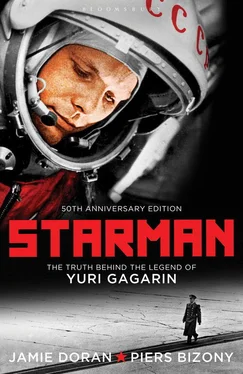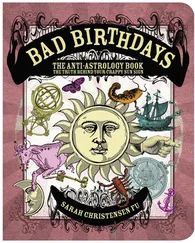The train screeched to a stop, and a small crowd of people jumped out and ran towards Titov, who recalls that he was not in the best of moods by then. ‘I said to them, “What are you staring at? Help me take off my spacesuit. I’m very tired.” There was supposed to be a clean lightweight overall for me to get into, but as usual somebody forgot to pack it in my emergency kit.’
A civilian woman arrived by car, who she had been in such a hurry to drive into the field that she drove over a pothole and banged her head on the steering wheel. To his bemusement, Titov found himself applying the bandages from his emergency space medical kit to her wound.
Sick, exhausted, bruised, befuddled but alive, Titov was the first man to spend an entire day in space, and the first to make multiple orbits around the earth. Perhaps he can take additional satisfaction from beating Gagarin at his own game. Saratov is 1,500 kilometres away from Baikonur, which means that Gagarin’s historic but incomplete first orbit on April 12 fell short by that distance; so Titov was actually the first man to complete a whole orbit. With all the fuss in the aerospace history books about Gagarin’s ‘altitude record’, this detail seems to have slipped everyone’s attention.
Titov is philosophical about the hazards that he and Gagarin endured aboard the temperamental Vostoks. ‘I can’t say I was ready for any of it, but we couldn’t train for these malfunctions, because with so few flights behind us, nobody knew what kind of things could go wrong. Yuri and I came up with our own emergency manual [for Vostok] and we tried to anticipate all the things that could create difficulties. I can tell you, that manual was a pretty thin document. When you drive a car, you have to expect a puncture at some point. Machines in motion have a right to go wrong.’
One week after Titov’s landing, construction of the Berlin Wall began. According to Korolev’s biographer James Harford, Khrushchev ordered the timing of Titov’s flight deliberately to encourage the German Democratic Republic (GDR) in its loyalty to Moscow. [7] Harford, Korolev , p. 178.
However, there was more to the relationship between Khrushchev and Kennedy than simple-minded East–West aggression. It is now becoming clear that the two men considered the possibility of collaboration in space. John Logsdon, who has researched this issue, says, ‘Kennedy was ambivalent about space even after he’d announced Apollo. In his Inaugural Address he suggested that the United States and the Soviet Union should explore space together, and that wasn’t simply rhetoric. He created a group of advisors to look for ways of increasing cooperation… He sent feelers through his brother Bobby into back channels at the Kremlin… We’re learning now that Khrushchev was ready to say, “Yes, let’s explore, let’s do it together.” If those two men had survived, history might have been different, but Kennedy was replaced by Lyndon Johnson, a very strong nationalist, and Khrushchev was ousted by Brezhnev, who was far more militaristic… The contingency of history is that you end up with things as they happened, not as they might have been.’
NASA considered a third sub-orbital mission to qualify Mercury for more demanding missions, but the puny Redstone rocket’s more powerful replacement, the Atlas (a fully fledged ICBM), was now ready to take a capsule into a full orbit, and the sub-orbital ‘hop’ schedule was cancelled. On February 20, 1962, John Glenn completed three full orbits and was applauded by US citizens, just as Gagarin had been in Russia. NASA also began testing unmanned prototypes for their giant Saturn lunar rockets. Admittedly they were only half the size of the superboosters that would eventually carry Apollo to the moon, but already they were close to outstripping the power of Korolev’s R-7.
Korolev urgently needed to develop a successor for Vostok, which was limited in its capabilities, but Khrushchev wanted further triumphs within weeks and months, not years. Andrian Nikolayev was launched on August 11, 1962 for a four-day mission, and Pavel Popovich went up the very next day for a three-day stint. For the first time two people were in space simultaneously. Korolev timed the launches so that the second Vostok would briefly come within seven kilometres of the first: a cosmic clay-pigeon shoot, which enabled the Soviets to claim a ‘space rendezvous’. In fact, the two craft quickly drifted apart and could never have regained their initial close formation. Their small rocket motors lay dormant throughout the flight, conserving fuel for re-entry braking at the end of the mission. However, appearances counted for a great deal. A number of aerospace professionals in the West were fooled into thinking that the Soviets had developed genuine rendezvous skills. In a 1995 interview with space historian James Harford, Vasily Mishin (who succeeded Korolev as chief of the OKB-1 Design Bureau in 1966) said, ‘With all the secrecy we had in those days, we didn’t tell the whole truth… As they say, a sleight of hand isn’t exactly a fraud. It was more like, our competitors [in the West] deceived themselves all on their own. Of course we didn’t want to shatter their illusions.’
The double Vostok mission seemed far in advance of American achievements. NASA launched astronaut Scott Carpenter on May 24, but it was hard not to see Mercury as a ‘second-best’ programme, by comparison with the remorseless originality of the Soviet missions. Even in the immediate wake of the Vostok double-flight, NASA’s response was simply ‘more of the same’, with an October 3 mission for Walter Schirra lasting just nine hours.
A few days later, US spy planes photographed Soviet missiles in secret bases on Cuba, and public attention in that terrifying autumn of 1962 turned from space to the very real prospect of global nuclear war – not as some dim and distant prospect but as a horror that might be unleashed at any moment. President Kennedy initiated a naval blockade of all Soviet shipping approaching Cuba. Given the stark alternatives – a formal US invasion of Cuba or an air strike against the missile bases – the blockade seemed the least dangerous of several extremely high-risk strategies available to him. As is now clear from recently released tapes of White House crisis meetings, Kennedy and his staff went to bed on the night of October 23 not knowing if they, or anyone else in the world, would be alive next morning. Kennedy and Khrushchev very nearly backed themselves into a corner from which they could not withdraw.
Boris Chertok, a senior rocket engineer, recalls in an interview with James Harford that another attempt to launch a Mars probe from Baikonur that fateful October was interrupted when the military ordered Chertok ‘to get the launch vehicle off the pad so they could replace it with an ICBM, because there was some kind of a national emergency. The military was using all the phone links, so I couldn’t get hold of Korolev, who was at home in Moscow ill with a cold. They told me I’d be court-marshalled if I didn’t move the Mars rocket away from the pad, and they began to check the systems on their missile. Only Korolev could have got through to Khrushchev to countermand these terrible instructions.’ [8] Ibid. p. 151.
Chertok flew to Moscow and went to Korolev’s house, where the Chief Designer solved the problem with a quick call to the Kremlin. By a horrible irony, when the Mars probe was launched on October 24, right in the middle of the Cuban crisis, it blew up, causing the ultra-alert US Ballistic Missile Early Warning System (BMEWS) to suspect a nuclear attack. Fortunately, the BMEWS tracking computers got to grips with the situation within a few seconds, and a counterstrike was not initiated.
Читать дальше












